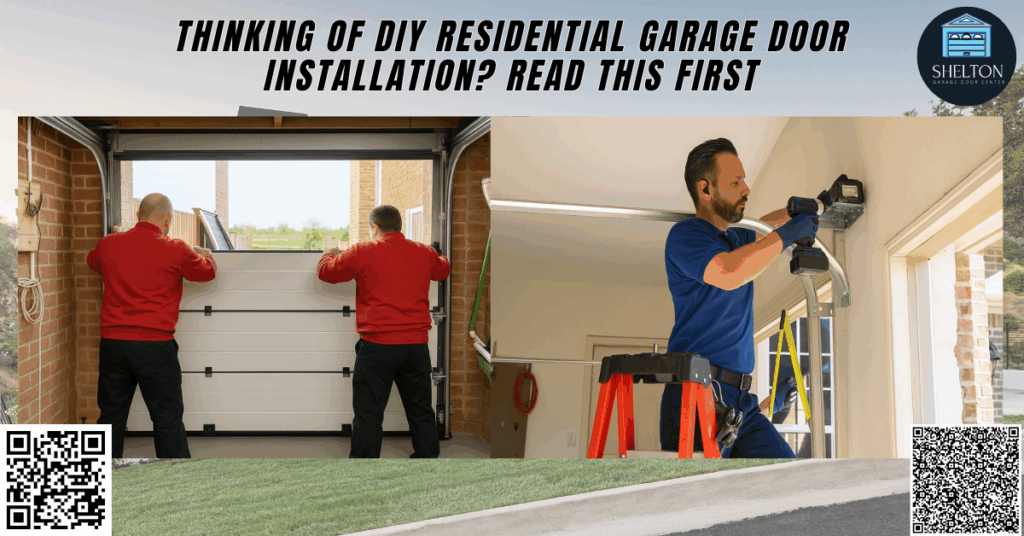By Shelton Garage Door Center – Expert Garage Door Services in Ansonia, CT
When a homeowner in Ansonia decided to install a new garage door on his own, he thought it would take just a weekend. But halfway through lifting the bottom panel into the garage opening, the vertical tracks shifted out of alignment, and the torsion springs weren’t properly wound. The result? A jammed system, a damaged garage door opener, and a call to our team at Shelton Garage Door Center to get everything safely corrected. This is a common situation we see with DIY installations gone wrong.
According to the U.S. Consumer Product Safety Commission, over 20,000 garage door-related injuries happen every year in the U.S., many involving torsion springs and garage door panels installed without professional oversight. The truth is, while garage doors may seem simple from the outside, their components, like spring tension, hinges, tracks, safety sensors, and torsion tubes, must be installed with precision.
If you’re thinking about tackling a residential garage door installation by yourself, this comprehensive guide will walk you through the reality of the process, tools, risks, and why professional garage door installation is often the safer and more cost-effective choice.
Why Homeowners Consider DIY Garage Door Installation
The appeal of DIY installation is understandable. Many homeowners believe they can save money on labor, have control over the process, and maybe even improve curb appeal with a stylish new door. With a basic understanding of home tools, it might seem like a manageable project.
You might be tempted by:
- Saving on installation costs
- Controlling the selection of garage door materials and style
- Choosing energy-efficient insulation options that suit your home’s climate
- Enjoying the satisfaction of completing a hands-on project
However, the installation of garage doors involves complex systems like torsion springs, vertical and horizontal tracks, center brackets, garage door panels, hinges, brackets, and cables. These systems require precise alignment and understanding of mechanical principles to ensure safe operation and long-term functionality.
The Complex Reality of Garage Door Installation
Installing a garage door is not like putting together a bookshelf or hanging a few shelves. It’s a multi-step process involving heavy, tension-loaded components that need exact calibration. Here are some key elements you must install correctly:
✅ Torsion Spring System
The torsion springs above the door must be carefully wound to the proper spring tension. This process requires winding bars, vise grips, and a strong understanding of how torque works. One slip and a spring could unwind violently, causing injury.
✅ Garage Door Panels and Hinges
Garage doors typically come in multiple sections (top section, bottom panel, middle panels), which are joined using hinges, bolts, and brackets. Each garage door panel must be aligned precisely with the next to ensure smooth movement along the tracks.
✅ Tracks and Brackets
Vertical tracks must be mounted flush with the garage door opening, while horizontal tracks must align with the ceiling joists using flag brackets and ceiling mounts. Improperly aligned tracks can cause the door to bind or fall.
✅ Garage Door Opener and Safety Sensors
Installing the garage door opener includes running power to the motor, aligning the trolley rail, and installing safety sensors at the base of the garage door. If installed incorrectly, the opener might strain or the safety sensors might not detect obstructions, leading to dangerous situations.
✅ Cable Drum and Torsion Tube
The torsion tube transfers force from the springs to the cable drums, which wind the lift cables that raise the door. Any miscalculation here affects balance, resulting in poor or unsafe garage door operation.
A successful installation depends on attention to every bolt, spring, panel, and bracket.
Tools and Materials You’ll Need
Before you even begin, gather the necessary tools and materials. Here’s a starter list:
🛠️ Essential Tools:
- Drill with a socket set
- Winding bars and a torque wrench
- Measuring tape and level
- Adjustable wrench and locking pliers (vise grip)
- Step ladder or scaffolding
- Clamps and safety glasses
- Hex lag screws, zinc-coated if outdoors
🧰 Materials:
- Garage door panels (insulated or non-insulated)
- Hinges, center bracket, and flag brackets
- Torsion springs and torsion tube
- Garage door opener with safety sensors
- Cable drums and lift cables
- Vertical and horizontal tracks
- Bottom seal, brackets, and mounting hardware
Understanding how to use these tools properly and how each component connects is crucial for a safe and effective installation.
The Cost of DIY Garage Door Installation
Many homeowners expect to save hundreds of dollars by skipping professional installation. But here’s what you might encounter:
- Specialized tools (like winding bars) are not included with the door
- Damaged parts from improper handling (panels, brackets, or springs)
- Voided warranties on doors or garage door openers due to self-installation
- Higher utility bills if insulation or bottom seals are improperly installed, reducing the R-value and energy efficiency
- Extra repair costs to fix mistakes, often higher than professional installation fees
In our experience, a large portion of DIY jobs in the Shelton/Ansonia area eventually result in professional callbacks.
Safety Hazards to Consider
Safety should always be your top priority. Every component of a garage door, from the torsion springs to the cable system, is under significant pressure and can cause injury.
Common DIY Mistakes Include:
- Improper spring tension leading to snapping springs
- Poor bracket installation that causes the door to fall
- Incorrect track alignment is causing binding or dragging
- Unsafe wiring that could lead to short circuits or opener failure
- Falling panels during installation due to insufficient support
Attempting to install a garage door without full knowledge of its mechanical system puts your safety and that of your family at risk.
Why Professional Garage Door Installation Is Worth It
At Shelton Garage Door Center, we provide safe, professional, and efficient installation services designed for the unique conditions of homes in Ansonia and surrounding areas.
Benefits of Hiring a Professional:
- Precision in setup for all panels, tracks, and springs
- Knowledge of local codes and best practices
- Safe installation of torsion springs and garage door openers
- Proper insulation and seal placement to ensure energy efficiency
- Warranty coverage on all labor and parts
- Time savings, as most installations take only a few hours
We ensure that every garage door section aligns perfectly, every bolt is secured, and every garage door opener is programmed for smooth, quiet, and secure operation.
When to DIY and When to Call a Pro
You Can DIY:
- Weatherstripping replacement
- Roller lubrication
- Sensor alignment
- Simple track cleaning
Leave It to the Pros If:
- You’re installing a new garage door
- Replacing torsion springs
- Mounting garage door openers
- Adjusting brackets, tracks, and cables
- You’re dealing with an old door that needs full removal
Professional installation ensures safe operation, longer equipment life, and better energy savings in the long run.
How Can Shelton Garage Door Center Help You?
If you’re located in Ansonia, CT, or surrounding areas, and considering a new residential garage door installation, Shelton Garage Door Center is your trusted local expert. We bring years of hands-on experience, attention to detail, and commitment to customer satisfaction with every project.
Here’s why homeowners across New Haven County trust us:
- Full-service installation and replacement for garage doors and garage door openers
- Expert configuration of torsion springs, tracks, brackets, and insulation systems
- Enhanced curb appeal with custom design and door styles
- Energy efficiency solutions with insulated panels and bottom seals
- Fast service, competitive pricing, and honest advice
📍 Shelton Garage Door Center
📍 Address: 20 Waterview Dr, Shelton, CT 06484
📞 Phone: (203) 718-5976
Don’t gamble with your safety or investment. Call Shelton Garage Door Center today for professional garage door installation that’s fast, safe, and built to last.
Frequently Asked Questions (FAQs)
1. How long does it typically take to install a garage door yourself?
DIY garage door installation can take anywhere from 6 to 12 hours or more, depending on your experience, the door type, and whether it’s a replacement or brand-new install.
2. Can I reuse parts from my old garage door during a new installation?
It’s not recommended—components like springs, tracks, and brackets wear over time and may not be compatible with your new system.
3. Is a permit required to install a garage door?
Some cities or counties require permits for garage door installation, especially if structural changes or electrical wiring for openers are involved—check with your local building department.
4. What type of insulation is best for garage doors in Connecticut?
For Connecticut’s climate, polyurethane or polystyrene insulation with a high R-value offers the best energy efficiency and temperature control.

